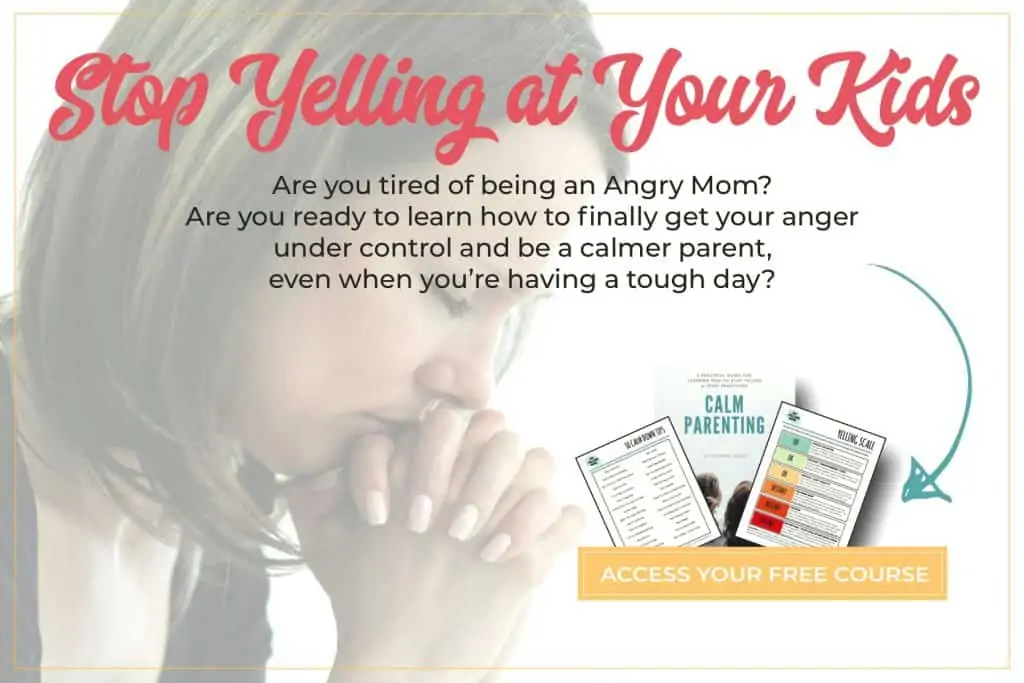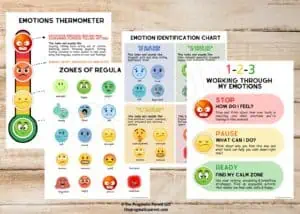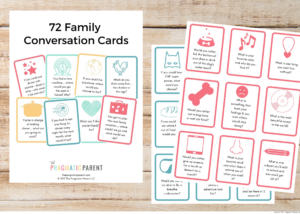How can we teach kids self-regulation? Self-regulation is the ability to have self control over ourselves – our emotions and actions. Children are not born with next-to-none of this ability, but develop it as they mature. These 10 fun games can help kids learn about impulse control and help them to strengthen these skills through play. If you’re stuck indoors, these games work like magic, or you can keep this stash of 104 printable activities on hand too!
10 Fun Games To Help Teach Kids Self Regulation Skills
As parents, some of the things we say make us feel like a broken record…
- Please put your clothes in the laundry basket
- We need to take turns, we switch after five minutes remember?
- Can you please turn off your bedroom light when you aren’t in your room
- We don’t jump off the couch
- Keep your hands to yourself
- Please don’t sit on the dog
- There’s no running in the house you can hurt yourself
- And the list goes on and on…
These every day (or every minute) occurrences with little kids can quickly turn to frustration.
When you’ve asked your little one to help or stop a habit for what feels like the 2 millionth time, yet they still do it, your blood starts to boil or you high-tail to the pantry where your hidden chocolate stash sits on the top shelf.
But here’s the thing… youngsters lack self-control until about the age of 3.5 – 4 which is why it seems like they’re always “breaking the rules” and testing limits.
Kids brains are still developing and until this cortex of their brain matures, right around the age of 3.5 to 4 years old, their impulses and emotional state remains immature.
This is why you see toddlers who act on their desires and act and react impulsively instead of thinking things through. They simply, can’t consider the ramifications of where their actions will lead, before they act or react.
By 3.5 – 4 Years of Age, Kids will Master…
- Self-control and understanding how to use restraint in a multitude of situations
- Impulse-control
- Sharing without conflict
- Taking turns
In the meantime, while your baby’s brain continues to take in the world and grow, you can help your child learn in a round-about and fun way about self-control and impulse-control.
As they grow up (elementary-school), it’s important to keep fostering these skills so they get honed and fine-tuned.
10 Fun Games You Can Play to Help Kids Learn Self-Control and Impulse-Control
Your child is still learning and it’s your job to be patient and teach them when they keep leaving their laundry all over the floor or forget to turn off the bedroom light.
They can’t get the hang of something or understand rules and expectations until the cortex of their brain hits a certain stage of development, but you can continue to play these fun games to teach them about self-control and impulse-control.
Most of these are classic games you’ve probably played a hundred times in your own youth, but didn’t know they did more than just for having a good time.
1) SIMON SAYS
The object of the game is to be the last one standing after everyone else has been eliminated for not listening and following Simon’s directions.
How to play: One person is designated as Simon, and the others are all players in the game. Simon must tell the players what to do, however, the players must only obey the commands that begin with the phrase “Simon Says….”
For example, if Simon Says to pat your head, the players should pat their head. If Simon says “hop in place” without saying “Simon Says” first, the players shouldn’t follow these directions or else they’ll be out.
2) RED LIGHT, GREEN LIGHT
The object of the game is to reach the end line before all the other players.
How to play: One player is the person who stands at the end line and calls out to the players on the playing field. The players stand on the other side of the field or space, and when the announcer calls out “green light” all the players run as fast as they can.
When the announcer calls out “red light” everyone must stop and anyone who fails to stop at that moment will have to return to the starting line.
3) STATUES
The objective of the game is to sneak up on the It person while his back is turned, but don’t get caught mid-run. The first Statue to tag the It person becomes the new It person and the game starts again.
How to play: Select one player to be the It person who stands on the opposite end of a field or play area from the other players, or Statues. When the It person, has his back to the Statues, they attempt to race across the field to tag him. But, when the It person turns around to face the Statues, they have to freeze in their spots and hold the pose for as long as the selected It person is looking at them.
Though the It person can approach and investigate the statues, he must be careful; when his back is turned to any Statues, they may move toward him. If a Statue is caught moving while the It person faces it, the Statue must return to the starting line.
4) HIDE N’ SEEK
The objective of the game is to find the best hiding spot and keep from being found. (last one hiding wins!)
How to play: One player closes their eyes and counts to 20 (or another predetermined numeral) while the rest of the players run to find a hiding spot. When the player finishes counting, the hunt for the rest of the players begins by yelling “Ready or Not, Here I Come!”
The game concludes when all the players are found. The next person could be the first or last person found, you make the rules.
5) SARDINES
The objective of the game is to find the hider before the rest of the group does, hide with him, and don’t be the last one.
How to play: This is a new style of hide-and-seek, flipped on its head. With the group’s player’s eyes closed and counting to 20 or a predetermined number, one person will go and hide. When the group finishes counting, the hunt begins.
The seekers spread out, trying to find the hiding spot of the one player. If they find him, they join him in the hiding place until all the seekers have found the hiding spot (packed in like sardines.)
The last player to find the hiding spot becomes the next person to hide!
6) FREEZE TAG
The object of the game is to avoid being frozen, and help save others from the deep freeze.
How to play: Similar to the game of tag, in this version, players who are tagged become “frozen” and must stand in play unmoving until they are “unfrozen.” They can become “unfrozen” by other players who are not frozen and tag them or crawl between their legs.
The game is over when everyone is tagged and frozen. If this is a large group, two taggers can work together to freeze players.
7) DUCK, DUCK GOOSE
The object of the game is to have fun while exercising and make sure everyone gets a turn at being a goose and being IT.
How to play: All of the players except one person who will start the game as IT, sits in a circle. It walks around the circle, tapping each person on the head gently saying “duck” each time, until he decides to tap one player on the head and say “goose.”
The person who he calls “goose” has to get up and chase It around the circle trying to tag him before It can sit down in his seat.
If the player successfully tags It before he sits down, it remains the tagger, but if the player doesn’t reach him in time, he comes the new person who goes around the circle saying “duck, duck, goose.”
8) MOTOR SKILLS GAME
The objective of motor games, is to follow the directions and listen to what you’re being told to do, which will keep changing.
How to play: One announcer will call out motor skills to the players who follow the directions.
Motor skills can include, run fast, crawl, move slow, walk backwards, jump, stop, hop like a frog, jump on one foot, roll over, jumping jacks, flap arms, etc.
9) DRUMMING
The object of the game is to follow the lead drummer and repeat the beat and patterns.
How to play: One lead drummer – using drums, boxes, pots and pans or anything else which makes noise – leads the group in a series of beats, patterns and sounds.
The drummer will lead slow, fast, stopping and different rhythms and cadences.
10) FOLLOW THE LEADER
The object of the game is to listen and observe the leader, and mimicry their movements.
How to play: The leader begins moving their body and the rest of the players must mimic the leader. The leader may incorporate motor skills like moving fast, slow, up, down, backwards, hopping, etc.
The leader may act like animal, scratch his head, do somersaults and no matter what the leader does, the others must duplicate these movements. Any players who don’t follow along or lag behind, get eliminated from the game.
The last person standing is the new leader.
Tips for Developing Age-Appropriate Self-Regulating Skills
While your little ones are developing at this fun age, here are some things to keep in mind with regards to feeling like you repeat requests constantly:
- Set appropriate limits with natural consequences – nothing that is too big of a ramifications or doesn’t align with the limit.
For example;
- if you throw your toys, I will have to take your toy, or
- if you chose to hit someone, you will have to go to a calm down space and play by yourself
Keep the lines of communication open and frequently discuss emotions and feelings to build emotional intelligence during development
Learn more about how to get your kids to listen the first time and set reasonable and fair consequences.
More Positive Parenting & Behavior Resources:
- Teaching Kids Self-Control: Overcoming “The Expectation Gap” When Setting Age-Appropriate Behavior Expectations
- How Can I Get My Kid’s Attention & to Listen to me Without Yelling?
- 18 Fun & Easy Outdoor Activities for Kids to Play Outside
- How Can I Help My Child Deal with Strong Emotions?
- 14 Factors That Influence a Child’s Behavior or Trigger Their Misbehavior
- The Brain Science Behind Outbursts (& How to Calm Down Kids)







Bridget says
Love this post! Sardines is a huge hit at our house. I particularly like having all these games in my back pocket with a group of kids, it’s so much easier for kids to become comfortable with one another when they engage in play. Perfect neighborhood games for kids of all ages too.
Poovanesh Pather | FamilyGrowthLife.com says
Great post. This is what parents need – articles on actionable steps on how to be better parents. I just love how you used common games to show the benefit to both parent and child.
Andie says
Funny how most of these games are games we played when I was a kid in the 80’s and early nineties. My theory is because we were forced to play outside all the time.